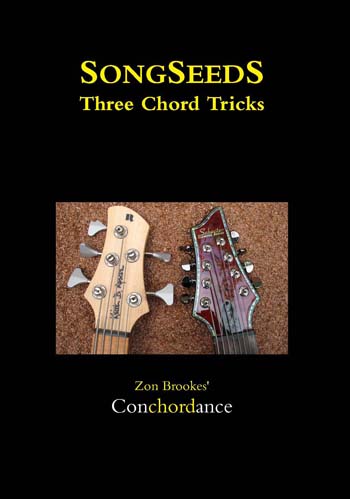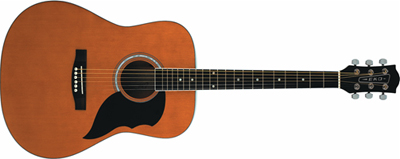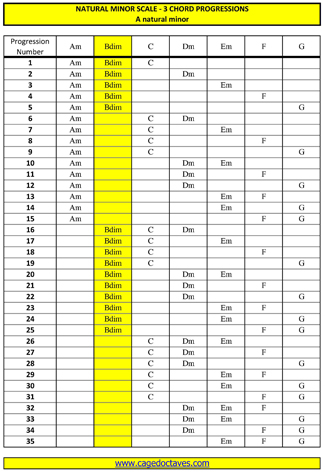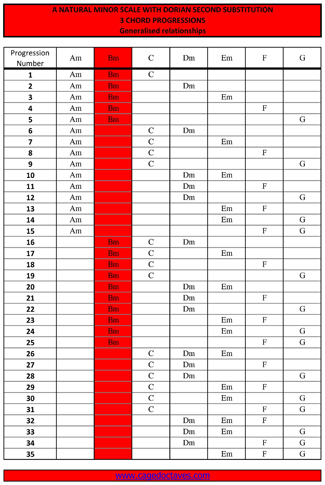SONGSEEDS - Three Chord Tricks
Conchordance
eBook :SONGSEEDS - Three Chord Tricks Conchordance is a systematic list of Three Chord Tricks that can be used as a reference book,song writing prompt or jamming tool. |
Paperbook Book :SONGSEEDS - Three Chord Tricks Conchordance is a systematic list of Three Chord Tricks that can be used as a reference book,song writing prompt or jamming tool. |
Björn Ulvaeus
|
|
Björn Ulvaeus is the guitar playing half of the Swedish songwriting partnership that is ABBA. |
|
Waterloo Eurovision 1974 (High Quality)
Thank You For The Music (live)
|
||
|
Eko manufactured the acoustic guitar seen in this ABBA Thank you for the music YouTube video.
|
|

MINOR SCALE THREE CHORD TRICKS
WITH DORIAN SECOND SUBSTITUTION
As explained in BLOGoZON No. 85 every natural minor scale generates a predictable series of chords (built using a mixture of major and minor third intervals); with the simplest having 3 notes (triads) and the most complicated using all 7 notes of the major scale (thirteenths).
The simplest major scale, from a note naming point of view, is C major as it has ZERO sharp (♯) or flat (♭) notes. Similarly the A natural minor scale is the simplest minor scale (as it is really the C major scale re-ordered to start on A natural rather than C natural); a table of the scale follows:-
INTERVAL NUMBER |
||||||
1 |
2 |
♭3 |
4 |
5 |
♭6 |
♭7 |
NOTE NAMES |
||||||
A |
B |
C |
D |
E |
F |
G |
Using the 7 chords generated from the natural minor scale (Aeolian mode) there are a total of 35 chord progressions (when 3 chords are selected at one time) and these relationships have been tabulated for A minor to the right. As demonstrated by the table shown right each chord appears a total of 15 times (from a total of 35 chord progressions) The presence of the diminished chord produces a big problem from a pop music point of view (rather than jazz) as the sound of this chord is considered too difficult for most listeners. As the Bdim chord is contained in three-sevenths of the available chord progressions it leaves a limited number of usable 3 chord tricks (20 out of an original 35); hence an alternative chord is required to replace it. The solution to the replacement of the Bdim chord is arrived at by examining the complete minor scale harmony chart for all 15 key signatures (shown below) and identifying how many times an Am chord appears. |
|
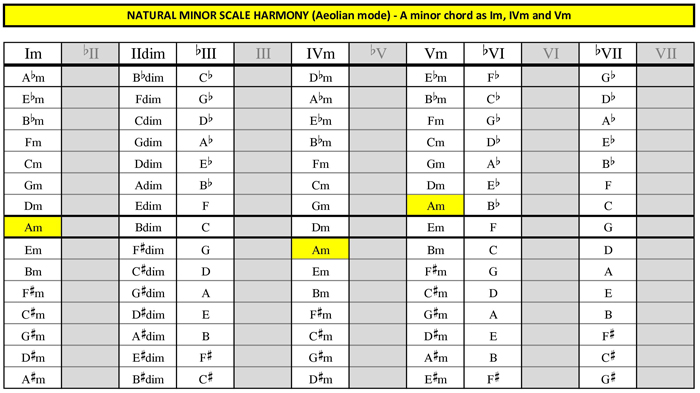
The Am chord appears a total of three times in the 15 available key signatures:-.
- as the Im chord in the key of A minor;
- as the IVm chord in the key of E minor;
- finally as the Vm chord in the key of D minor.
This produces two available solutions to the replacement of the Bdim chord in the 15 chord progressions where it makes an appearance (see above);this BLOGoZON examines the substitution chord produced where Am appears as the number IVm chord in the key of E minor.
The table that follows shows the natural minor scale generated harmony (3 note scale chords) for the keys of both A minor and E minor with the number IVm chord of E minor (Am) highlighted.

If the scale chords for the key of E minor are rearranged so that A minor is the starting chord this is known as the harmonized A dorian mode; which is tabulated below:-

Thus the IIm chord of the harmonized A dorian mode (B minor chord) can be used as a substitution (replacement) chord for the IIdim of the harmonized A minor scale (B diminished chord); as highlighted in the tables that follow:-

The table above can also be generated for all seven SHARP minor scales as defined by the CYCLE OF FIFTHS
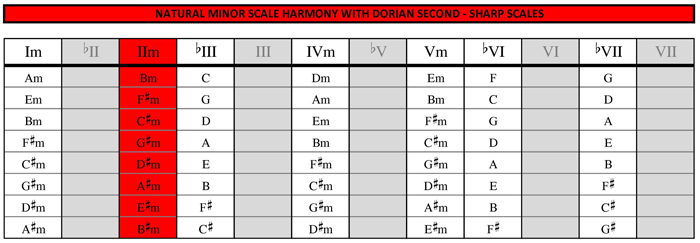
Similarly the table can be produced for the FLAT minor scales as defined by the CYCLE OF FOURTHS
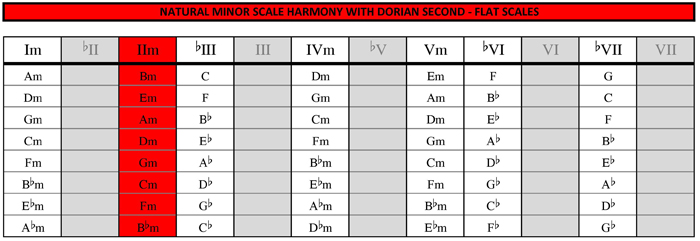
| Again using the 7 chords generated from the A minor scale (Aeolian mode) there are a total of 35 chord progressions (when 3 chords are selected at one time) and these relationships have been tabulated for a minor to the right. As previously demonstrated above each chord appears a total of 15 times (in the table shown right) and this now includes the substitution chord Bm. The problem sound created by the difficult Bdim chord has been solved by replacing it (substituting) with the Bm chord. As the Bdim chord was contained in three-sevenths of the available chord progressions it brings the number of usable 3 chord tricks back up to 35 (where Bdim represented 15 out of the original 35 chord progressions). |
|
Every one of the 35 numerically ordered 3 CHORD TRICKS (progressions) can be re-ordered a further 6 times, which produces a total of 210 potential SONGSEEDS for each and every key signature. An example table follows for chord progression number 1, which has a generalised relationship of Im, IIm, ♭III :-
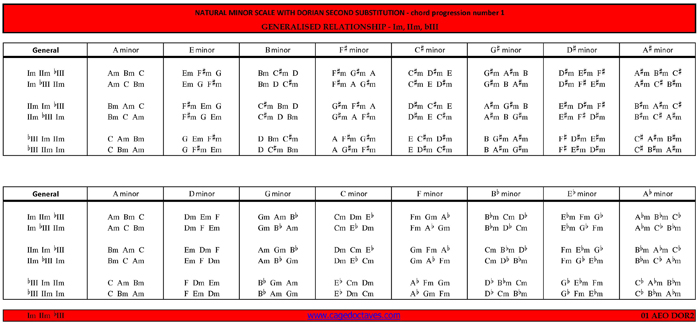
The question is "Has any of this music theory nonsense been used to write any decent songs that both sounded good and made some money for the writer?"
Answer: This type of chord progression is a VERY rare beast indeed; as at this moment in time no examples can be quoted.
This is good news for all those songwriters out there who want to write something a little bit ORIGINAL for once!
|
Who found out that nothing |


